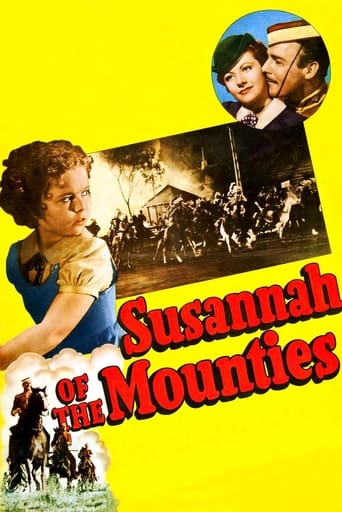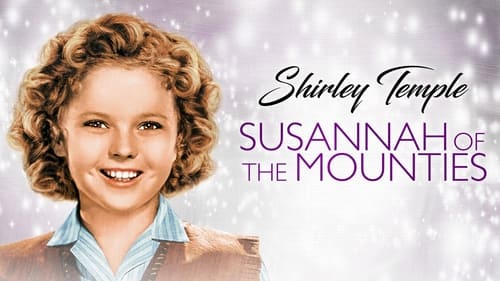TxMike
I managed to catch this movie on Movies! channel. For a 1939 movie the cinematography and sound are very good.It if course stars 10-yr-old Shirley Temple who already was very experienced in movie roles. She is little Susannah Sheldon, called Sue for short. As the movie opens we see that she is the lone survivor of an Indian attack on her family's wagon. Set in the NW Territory the main male star is Randolph Scott as Canadian Mountie, Inspector Angus Montague, usually just called Monty for short. He comes upon the burned and destroyed wagon and brings little Sue to safety. The core of the story is strained relations between the white man and the Indians, during the time when cross-country railways were being built, threatening the native lands. After a meeting the local tribal chief agrees to leave collateral as a sign of his sincerity, and that collateral is his son, first-time actor Martin Good Rider, about 14, as Little Chief. After a very rocky start he and little Sue become good friends in the fort.Sue is so taken with her rescuer, Monty, that she begins to imagine herself as his long-term companion. When pretty Margaret Lockwood as Vicky Standing shows up, and Monty starts to show interest in her, little Sue begins to show signs of jealousy.In the end an incident threatens to drive the parties apart but little Sue brings forth some information that saves the day. Young Shirley Temple was indeed a fine actress and she deserves all the attention she received over the years.
classicsoncall
Right out of the gate you get a surprise with this film when you see Shirley Temple's name above both Randolph Scott and Margaret Lockwood during the opening credits. I happened to catch the colorized version of this picture on Turner Classics, and it had it's good and bad points. The filming locations included some impressive scenery, but at the same time some of the long shots like those of the Indian camp looked like rear screen projection photography. It was a bit distracting in those instances.I caught this picture shortly after seeing Shirley in 1936's "Stowaway" with Robert Young, and the three year difference in her age is noteworthy. In "Stowaway" she was just about at the height of her popularity; as the older Susannah Sheldon here some of the charm seems to have worn off of her persona. Not that she doesn't have an affecting screen presence, but the more 'mature' aspect of her character requires a bit more workmanship and the situations she finds herself in are more adult like.I take political correctness in stride but I wonder how modern day viewers watch a movie like this today. There's plenty to get worked up about if one's a feminist or sensitive about racial intolerance. Susannah berates Mountie Pat O'Hannegan for doing a womanly chore like sewing a button on his uniform, while Shirley's opposite Little Chief (Martin Good Rider) scolds her for walking or riding ahead of him, he being a male and she being a mere squaw. I liked the way Little Chief ironed things out later in the story with 'Little Golden Hawk' by making her his 'blood brother'.For a Shirley Temple picture, there's not much in the way of song or dance, though she does manage to teach Inspector Angus Montague (Scott) how to waltz so he can effectively romance Miss Vicky Standing (Lockwood). I'd have to say I was impressed with the actress's wardrobe throughout the story, in color her gowns and dresses were quite fashionable.In terms of adventure, the movie did have it's share of cowboy, in this case Mountie versus Indian action, some of it quite vicious from a family viewing standpoint. I was going to have my young granddaughter watch this with me until I previewed it; I think I'll wait a while on that idea. But the resolution of the story is done effectively, with 'Little Golden Hawk' standing her ground with Blackfoot Chief Big Eagle to save Mountie Monty's hide and uncover the treachery of renegade Indian Wolf Pelt (Victor Jory). The closing scene of Shirley smoking the peace pipe is a well placed subliminal message to young viewers of all eras to refrain from smoking altogether.
weezeralfalfa
Essentially, a lesser remake of "Wee Willie Winkie", in a setting of sometimes hostile Canadian Native Americans, instead of thieving tribal Afghans, in another part of the British Empire, of the times. Very vaguely inspired by the novel of the same title. The second and final appearance of ruggedly handsome, charming, Randolph Scott, as the male lead in a Shirley Temple film. Actually, this wasn't their first dual appearance in a western. Back in 1933, 5 y.o. Shirley had a minor role in the Scott western "To the Last Man". Their second appearance together, in "Rebecca of Sunnybrook Farm", is the best of the 3 films, for various reasons. I couldn't believe my eyes when, in the opening scene, with Scott leading a routine patrol of Mounties. They are wearing silly-looking bell hop caps, instead of the wide-brimmed 'police hats' we normally associate with the RCMP, or the 'pith helmets' sometimes worn in the earlier days of the North-West Mounted Police(NWMP)(The RCMP wasn't named as such until 1920). There must be a story behind this glaring travesty of decorum, but I don't know it. Very unusually, Scott is sporting a moustache, which seems to be a requirement for being a Mountie, since all the others have a similar moustache. Also, in the colorized version which I saw, their jackets are a dull orange, rather than the cardinal red traditional RCMP. The historical setting of the plot is equally unhistorical. It has certain elements of the Blackfoot attacking settlers and crews building the Canadian transcontinental railroad, which places this story in the 1880s. Well, the Blackfoot never joined the Sioux, Arapaho and northern Cheyenne, to the south, in their armed resistance to European expansion and the building of railroads across their hunting grounds, which by then had long ago been depopulated of their essential bison prey. On the other hand, some actual Blackfoot were included among the costumed Native Americans. This is more authentic than most westerns of this general era. Even John Ford usually cast his familiar Navahos as Apaches, Comanche, Cheyenne, etc. The NWMP patrol led by Scott, as Monty, comes upon the remains of a wagon train, with no apparent survivors of an apparent 'Indian' attack, until a barrel is noticed rocking a bit. Inside they find Shirley(Susannah) who, strangely, initially is fearful of them, rather than relieved. Obviously, someone else must have placed the barrel over her, and it's strange the attackers didn't investigate the contents of the barrel, as possible plunder. Since Susannah doesn't seem to have any surviving relatives, it's decided to keep her at the post for a while. with Monty and Pat(J. Farrell MacDonald) serving as her unofficial guardians. Pat makes or buys her a new outfit, Susannah being surprised that he can sew well. His awful toupee, which he only occasionally wears, becomes a running gag, as naïve Susannah uses it to polish Monty's boots, then later it keeps being shot off during a Blackfoot attack on the Mounties' compound. Beautiful Brit, Margaret Lockwood, cast as the superintendent's visiting daughter(Vicky) soon shows up. She and Monty immediately hit it off romantically, causing great jealousy on the part of 11 y. o. Susannah, who now considers Monty 'her man', acting the part of a wife in taking care of some of his domestic chores. She is greatly relieved when it's decided that city girl Vicky will return to Toronto, while Monty will remain at the post. Susannah's other new male in her life is Blackfoot Little Chief: son of Chief Big Eagle. The Blackfoot, real and fake, speak in stereotypical Hollywood 'Indian pidgin English', often in the extreme, with just 'unh' for yes. Little Chief exhibits this in the extreme. Although Susannah initially hates Little Chief for his dismissal of her as a mere childish squaw, with all the implications relating to Blackfoot squaws, eventually they strike up a bit of a friendship, even mingling blood from their fingers, supposedly making them 'blood brothers'. They also smoke a makeshift peace pipe together, with Susannah supposedly feeling sick and dizzy afterward. This is repeated in the final scene when, at a peace council, she is forced to smoke a real peace pipe, since she was instrumental in bringing out the truth about the stolen horses and supposed plan of the Canadian Army to attack the Blackfoot, thus causing Big Eagle to declare an end to hostilities. Again, she initially smiles, then frowns, clutching her throat. Shirley would begin a lifelong smoking habit in just a few years, which would eventually lead to her death just a year ago, from lung dysfunction. Shirley's trademark dancing and singing is confined to teaching Monty to waltz, so he can dance with Vicky before she leaves......Humor is mostly confined to cultural conflicts between Susannah and Little Chief, Pat's toupee, and Susannah's jealousy relating to Vicky.....At times, there's a good deal of war-whooping and dancing, and shots of masses of 'Indians' riding horses on a war mission... During the Blackfoot night attack on the Mounties' post, it appears that most of the complex is on fire. Yet, in the morning, there appears to be only minor damage, quickly being repaired......In the critical matter of determining whether Susannah + Little Chief or Wolf Pelt is telling the truth about the stolen horses and Canadian troops, the medicine man employs a 'truth stick', placed vertically, supposedly falling toward the liar. I couldn't find any historical reference for any culture using such. However, in principle, it rather resembles 'trial by ordeal' or trial by other methods based mostly on chance.




